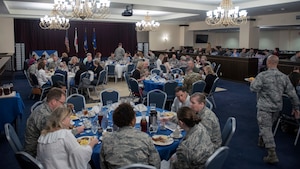By Air Force Staff Sgt. Michael J. Kelly, 132nd Wing, Iowa
Air National Guard
JOINT BASE PEARL HARBOR-HICKAM, Hawaii, March 5, 2018 — About
70 airmen with the Iowa Air National Guard’s 132nd Wing deployed here for
Exercise Sentry Aloha, Feb. 10-23, to develop their deployment readiness skills
alongside their active duty and Hawaii Air National Guard counterparts.
Airmen from civil engineering, emergency management, fire
emergency services, communications, security forces, force support squadron and
medical all trained in a variety of environments and scenarios with local
active duty and guard members.
The emergency management team trained about 466 active duty,
National Guard, and Air Force Reserve airmen in chemical, biological,
radiological, nuclear attack survival skills. The training included proper use
of CBRN equipment, simulation of different disaster scenarios, decontamination
training and self-aid and buddy care.
“Getting to see the different perspective each instructor
brings really helps pinpoint better ways to help people survive, especially
those deploying,” said Air Force Tech. Sgt. Rachel Albee, a 132nd Wing
emergency management team member.
The emergency management team had access to equipment and
facilities unavailable at their home station, which allowed them to effectively
train airmen for disaster scenarios. Their efforts were instrumental in
deployment readiness of the Hawaii airmen and were greatly appreciated.
“They integrated well with our flight members and provided much
needed support in the readiness surge getting airmen deployment-ready,” said
Air Force Master Sgt. Kareem Fuertes, the emergency manager for the Hawaii Air
National Guard’s 154th Wing.
Weapons, Medical Training
Instructors from the 132nd Security Forces Squadron’s combat
arms training and maintenance team oversaw the weapons training and
qualification for deploying Hawaii airmen. The training was conducted in a new,
state-of-the-art indoor range, which allowed for a greater diversity of
shooting scenarios and allowed for faster qualification time.
“It was great being able to see how it works and talk to the
[combat arms training and maintenance] group here to find out the pros, cons
and all the maintenance that is needed if we were able to obtain one,” said Air
Force Tech. Sgt. Savannah Page, a combat arms training and maintenance
instructor for the 132nd Security Forces Squadron.
The 132nd Medical Group trained on administrative systems
and also worked real-world medical operations at Tripler Army Hospital in
Honolulu. The training included a rare hands-on medical evacuation training
mission -- the loading and unloading of patients in critical condition from
aircraft. The training, which most Air National Guardsmen seldom receive except
in deployed locations, presented many challenges that the 132nd Medical Group
used to prepare themselves for future missions.
“The biggest obstacle for the training is the
unpredictability of the actual flights,” said Air Force Staff Sgt. Kelsey
Searls. “Aircraft availability, stability of the patients, weather, paperwork;
all of it can change the flight times at any moment, making training on actual
aircraft and running live missions, sometimes impossible to get during an
annual training tour.”
Force Support
The 132nd Communications Flight worked on a variety of
projects on base including inventorying equipment, disposing outdated computer
hard drives and tapes as well as prepare underground network cables for use in
base operations. They also upgraded the base’s computer systems and software.
“It was great getting to work with new people in a total
force integrated environment,” said Air Force Senior Airman Ben Trotter, a
spectrum operations technician with the 132nd Communications Flight. “We
provided manpower, which organized their assets as well as training for us,
which will make us a more efficient communications flight.”
Communications flight airmen disposed of more than 200
computer hard drives, inventoried and processed in about 250 computers, updated
the software on 40 computers and fixed about five thousand feet of network
cable.
The 132nd Force Support Squadron’s services airmen provided
meals at the Hale Aina Dining Facility on Joint Base Pearl Harbor-Hickam. The
airmen were able take inventory of the produce and supplies of the dining
facility which helped them gain more knowledge of accountability systems.
“Working hand-in-hand with the active duty was rewarding, as
was the mutual exchange of ideas and knowledge of the services field, which
will make our shop better,” said Chris Newton, the services shift leader for
the 132nd Force Support Squadron.
The airmen also helped prepare a special meal for the base
in honor of Black History Month. In total, the 132nd Force Support Squadron
served about five thousand meals to active duty, guard and reserve airmen. They
also conducted physical training tests for about 500 airmen.
Sentry Aloha exercises are held to provide the Air National
Guard, Air Force and other Defense Department agencies an opportunity to
execute current, realistic, integrated training specifically designed to
develop combat operations and skill sets.








